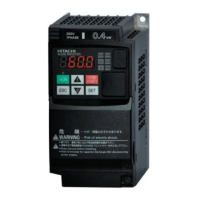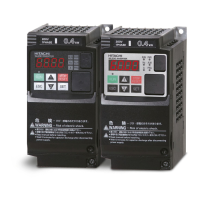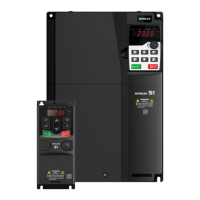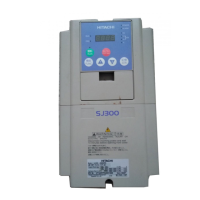Chapter 9 Inverter Functions
9-6-1
9.6 Speed/Torque Control According to Load
9.6.1 Speed Control and Torque Control
The following two modes of high precision motor control are available for inverters, both of
which can be used when the "Control mode selection [A044]" is set to "Sensorless vector control
(SLV) (IM) (03)".
(1) Speed control: This method controls the output to produce torque at a constant speed by
having the motor speed follow the speed command.
(2) Torque control: This method controls the output so that the output torque follows the torque
command and remains constant regardless of speed.
The torque-related functions described in this section are only available when using sensorless
vector control. For details on configuring and adjusting sensorless vector control, refer to "9.5.7
Driving with Sensorless Vector Control".
For the torque value of each function, the torque equivalent to the inverter's rated output
current is used as the reference value (100%). Therefore, note that the absolute torque value
will vary depending on the motor combination in use.
■ Differences between speed control and torque control
"Speed control" is a control method in
which the motor rotation speed follows a
speed command. Therefore, the motor
rotation speed is controlled to maintain a
constant speed even when the load torque
fluctuates.
"Torque control" is a control method in
which the output torque follows the torque
command. Therefore, the motor rotation
speed fluctuates in response to changes in
load torque.
■ Summary of speed/torque control-related functions
Output torque
monitor function
The "Output torque monitor [d012]" is used during sensorless
vector control to monitor estimated output torque values.
Further, analog output from the [Ao1] terminal, and pulse output
from the [Ao2] terminal are also available. For details, refer to
"9.16.3 Outputting Monitor Data by Pulse Output" and "9.16.4
Outputting Monitor Data by Analog Output".
Speed control
Torque control
This controls the output torque of the motor to prevent it from
exceeding the specified torque limit value, even if the load
conditions change. This is used in applications where the
absolute minimum amount of force is applied, such as in push
operations.
Speed control
Torque control
Speed/torque
control switching
This function switches between speed control and torque
control.
Speed control
Torque control
A separate torque bias value is added to the command torque
during speed control or torque control.
This controls the output torque to follow the torque command
value. This is used in applications where a constant torque is
required, even if varying outside forces are applied, such as for
winding machines and other applications where a constant
tensile force must be maintained. In addition, a speed limit at
torque control function can be set when in torque control mode,
as the motor speed will continue to increase if the load becomes
too light in relation to the torque command.

